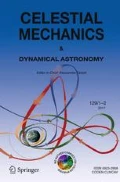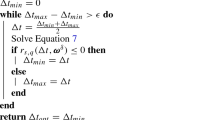Abstract
Lambert’s problem is the two-point boundary value problem for Keplerian dynamics. The parameter and solution space is surveyed for both the zero- and multiple-revolution problems, including a detailed look at the stress cases that typically plague Lambert solvers. The problem domain, independent of formulation, is shown to be rectangular for each revolution case, making the elusive initial guess and the solution itself amenable for interpolation. Biquintic splines are implemented to achieve continuous derivatives and quick evaluation. Resulting functions may be used directly as low-fidelity solutions or used with a single update iteration without safeguards. A concise, improved vercosine formulation of the Lambert problem is presented, including new singularity-free and precision-saving equations. The interpolation scheme is applied for up to 100 revolutions. The domain considered includes all practically conceivable flight times, and every possible geometry except a small region near the only physical singularity of the problem: the equal terminal vector case. The solutions are archived and benchmarked for accuracy, memory footprint, and speed. For typical scenarios, users can expect \(\sim 6\) or more digits of velocity vector accuracy using an interpolated solution without iteration. Using a single, unguarded iteration leads to solutions with near machine precision accuracy over the full domain, including the most extreme scenarios. Depending on desired resolution, coefficient files vary in size from \(\sim 3\) to 65 MB for each revolution case. Evaluation runtimes vary from \(\sim 2\) to 5 times faster than the industry benchmark Gooding algorithm. The coefficient files and driver routines are provided online. While the method is currently demonstrated on the vercosine formulation, the 2D interpolation scheme stands to benefit all Lambert problem formulations.

















Similar content being viewed by others
Notes
Ryan P. Russell. (2019, October 14). ivLam (Version 1.06). Zenodo. http://doi.org/10.5281/zenodo.3479924; Also see http://russell.ae.utexas.edu/index_files/lambert.html
In practice, other variables, such as \(r_1\), are commonly set to unity for normalization. However, the objective of the current exercise is to reduce the number of variables in f from Eq. 4. Since \(r_1\) does not directly appear in f, there is no current benefit of normalizing \(r_1\). Therefore, we are limited to normalizing q or c because both appear in f and have units of length.
References
Ahn, J., Bang, J., Lee, S.I.: Acceleration of zero-revolution Lambert’s algorithms using table-based initialization. J. Guid. Control Dyn. 38(2), 335–342 (2015). https://doi.org/10.2514/1.G000764
Arora, N., Russell, R.P.: A fast and robust multiple revolution Lambert algorithm using a cosine transformation. In: AAS/AIAA Astrodynamics Specialist Conference, AAS 13-728, Hilton Head, SC (2013)
Arora, N., Russell, R.P., Strange, N., Ottesen, D.: Partial derivatives of the solution to the Lambert boundary value problem. J. Guid. Control Dyn. 38(9), 1563–1572 (2015). https://doi.org/10.2514/1.G001030
Avanzini, G.: A simple Lambert algorithm. J. Guid. Control Dyn. 31(6), 1587–1594 (2008). https://doi.org/10.2514/1.36426
Bate, R.R., Mueller, D.D., White, J.E.: Fundamentals of Astrodynamics. Dover, Mineola (1971)
Battin, R.H.: Lambert’s problem revisited. AIAA J. 15(5), 707–713 (1977). https://doi.org/10.2514/3.60680
Battin, R.H.: An Introduction to the Mathematics and Methods of Astrodynamics. AIAA Education Series, Reston (1999)
Bombardelli, C., Gonzalo, J.L., Roa, J.: Approximate analytical solution of the multiple revolution Lambert’s targeting problem. J. Guid. Control Dyn. 41(3), 792–801 (2018). https://doi.org/10.2514/1.G002887
Colasurdo, G., Zavoli, A., Longo, A., Casalino, L., Simeoni, F.: Tour of Jupiter Galilean moons: winning solution of GTOC6. Acta Astronaut. 102, 190–199 (2014). https://doi.org/10.1016/j.actaastro.2014.06.003
Der, G.: The Superior Lambert Algorithm. In: Advanced Maui Optical and Space Surveillance Technologies Conference, p. E50 (2011)
Escobal, P.R.: Methods of Orbit Determination. Wiley, Hoboken (1965)
Fornberg, B.: Numerical differentiation of analytic functions. ACM Trans. Math. Softw. 7(4), 512–526 (1981). https://doi.org/10.1145/355972.355979
Gauss, C.F.: Theory of the motion of the heavenly bodies moving about the sun in conic sections, a translation of Gauss’s Theoria motus. Little Brown and Company, Boston; Translator: Davis, Charles Henry (1857). https://www.biodiversitylibrary.org/item/58729, https://www.biodiversitylibrary.org/bibliography/19023
Gooding, R.H.: A procedure for the solution of Lambert’s orbital boundary-value problem. Celest. Mech. Dyn. Astron. 48(2), 145–165 (1990). https://doi.org/10.1007/BF00049511
He, Q., Li, J., Han, C.: Multiple-revolution solutions of the transverse-eccentricity-based Lambert problem. J. Guid. Control Dyn. 33(1), 265–269 (2010). https://doi.org/10.2514/1.45041
Healy, L.M.: Lambert targeting for on-orbit delivery of debris remediation dust. J. Spacecr. Rockets 51(5), 1485–1491 (2014). https://doi.org/10.2514/1.A32634
Healy, L.M., Binz, C.R., Kindl, S.: Orbital dynamic admittance and earth shadow. J. Astronaut. Sci. (2019). https://doi.org/10.1007/s40295-018-00144-1
Herrick, S., Liu, A.: Two body orbit determination from two positions and time of flight. Appendix A, Aeronutronic C-365 (1959)
Herrick, S.: Astrodynamics: Orbit determination, space navigation, celestial mechanics, vol. 1. Van Nostrand Reinhold Company, London (1971)
Izzo, D.: Revisiting Lambert’s problem. Celest. Mech. Dyn. Astron. 121(1), 1–15 (2015). https://doi.org/10.1007/s10569-014-9587-y
Jezewski, D.J.: K/S two-point-boundary-value problems. Celest. Mech. Dyn. Astron. 14(1), 105–111 (1976). https://doi.org/10.1007/BF01247136
Junkins, J.L., Miller, G.W., Jancaitis, J.R.: A weighting function approach to modeling of irregular surfaces. J. Geophys. Res. 78(11), 1794–1803 (1973). https://doi.org/10.1029/JB078i011p01794
Klumpp, A.R.: New developments in astrodynamics algorithms for autonomous rendezvous. In: JPL Document No. 19930013090 (1991)
Kriz, J.: A uniform solution of the Lambert problem. Celest. Mech. Dyn. Astron. 14(4), 509–513 (1976). https://doi.org/10.1007/BF01229061
Lancaster, E.R., Blanchard, R.C.: A unified form of Lambert’s theorem, NASA TN D-5368. Technical report, NASA (1969)
Lancaster, E.R., Blanchard, R.C., Devaney, R.A.: A note on Lambert’s theorem. J. Spacecr. Rockets 3(9), 1436–1438 (1966). https://doi.org/10.2514/3.28673
Lantoine, G., Russell, R.P., Dargent, T.: Using multicomplex variables for automatic computation of high-order derivatives. ACM Trans. Math. Softw. 38(3), 16:1–16:21 (2012). 10.1145/2168773.2168774
Longuski, J.M., Williams, S.N.: Automated design of gravity-assist trajectories to mars and the outer planets. Celest. Mech. Dyn. Astron. 52, 207–220 (1991). https://doi.org/10.1007/BF00048484
Mahajan, B., Vadali, S.R.: Two-body orbital boundary value problems in regularized coordinates. In: AAS/AIAA Astrodynamics Specialist Conference, AAS 18-310, Snowbird, UT (2018)
Nelson, S.L., Zarchan, P.: Alternative approach to the solution of Lambert’s problem. J. Guid. Control Dyn. 15, 1003–1009 (1992)
Ochoa, S.I., Prussing, J.E.: Multiple revolution solutions to Lambert’s problem. Adv. Astronaut. Sci. 79(2), 1989–2008 (1992)
Ottesen, D., Russell, R.P.: Space trajectory optimization using embedded boundary value problems. In: AAS/AIAA Astrodynamics Specialist Conference, AAS 17-837, Stevenson, WA (2017)
Pellegrini, E., Russell, R.P., Vittaldev, V.: F and G Taylor series solutions to the Stark and Kepler problems with Sundman transformations. Celest. Mech. Dyn. Astron. 118, 355–378 (2014). https://doi.org/10.1007/s10569-014-9538-7
Peterson, G., Campbell, E.T., Balbas, J., Ivy, S., Merkurjev, E., Hall, T., et al.: Relative performance of Lambert solvers 1: zero revolution methods. Adv. Astronaut. Sci. 136(1), 1495–1510 (2010)
Petropoulos, A.E., Kowalkowski, T.D., Vavrina, M.A., Parcher, D.W., Finlayson, P.A., Whiffen, G.J., et al.: 1st ACT global trajectory optimisation competition: results found at the Jet Propulsion Laboratory. Acta Astronaut. 61(9), 806–815 (2007). https://doi.org/10.1016/j.actaastro.2007.03.013
Psiaki, M.L., Ward, K.C., DeMars, K.J.: A Bi-quintic latitude/longitude spline and lunar surface modeling for spacecraft navigation. J. Astronaut. Sci. (2018). https://doi.org/10.1007/s40295-019-00192-1
Russell, R.P., Ocampo, C.A.: Geometric analysis of free-return trajectories following a gravity-assisted flyby. J. Spacecr. Rockets 42(1), 138–152 (2005). https://doi.org/10.2514/1.5571
Russell, W.S.: Polynomial interpolation schemes for internal derivative distributions on structured grids. Appl. Numer. Math. 17(2), 129–171 (1995). https://doi.org/10.1016/0168-9274(95)00014-L
Shen, H., Tsiotras, P.: Optimal two-impulse rendezvous between two circular orbits using multiple-revolution Lambert’s solutions. J. Guid. Control Dyn. 26, 50–61 (2003). https://doi.org/10.2514/2.5014
Stiefel, E.L., Scheifele, G.: Linear and Regular Celestial Mechanics; Perturbed Two-body Motion, Numerical Methods. Canonical Theory. Springer, Berlin (1971)
Sun, F.T.: On the orbital isochronism. Celest. Mech. 3, 272–288 (1971). https://doi.org/10.1007/BF01231801
Thorne, J.D.: Lambert’s theorem–a complete series solution. Adv. Astronaut. Sci. 119(3), 3061–3074 (2004)
Torre, D.D.L., Fantino, E.: Review of Lambert’s problem. In: ISSFD 2015: 25th International Symposium on Space Flight Dynamics, Munich, Germany, pp. 1–15 (2004). http://hdl.handle.net/2117/86429
Torre, D.D.L., Flores, R., Fantino, E.: On the solution of Lambart’s problem by regularization. Acta Astronautica 153, 26–38 (2018). http://www.sciencedirect.com/science/article/pii/S0094576518306106
Vallado, D.: Fundamentals of Astrodynamics and Applications, 4th edn. Microcosm Press, Hawthorne (2013)
Acknowledgements
The author thanks Nitin Arora, John Goodman, David Vallado, and the anonymous reviewers for valuable insights and dialogue relating to the Lambert problem and code implementations.
Author information
Authors and Affiliations
Corresponding author
Ethics declarations
Conflicts of interest
The author declares that he has no conflict of interest.
Additional information
Publisher's Note
Springer Nature remains neutral with regard to jurisdictional claims in published maps and institutional affiliations.
This article is part of the topical collection on 50 years of Celestial Mechanics and Dynamical Astronomy.
Guest Editors: Editorial Committee.
Rights and permissions
About this article
Cite this article
Russell, R.P. On the solution to every Lambert problem. Celest Mech Dyn Astr 131, 50 (2019). https://doi.org/10.1007/s10569-019-9927-z
Received:
Revised:
Accepted:
Published:
DOI: https://doi.org/10.1007/s10569-019-9927-z




